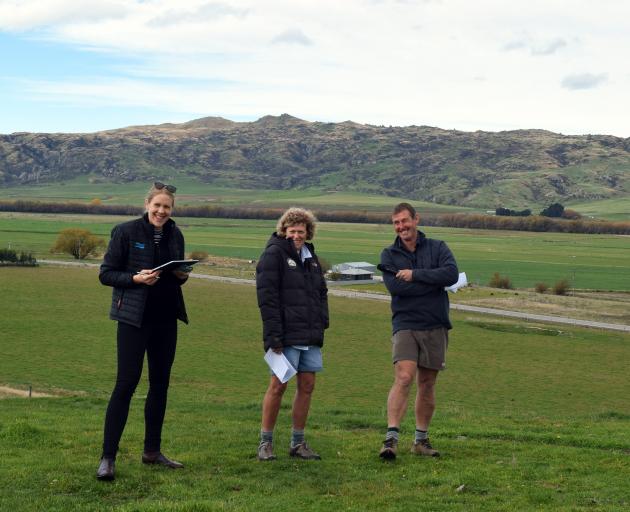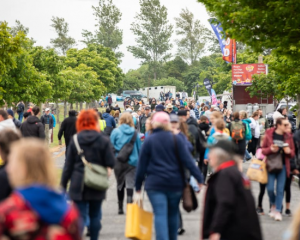

More than 70 people attended a Beef + Lamb Central Otago farming-for-profit field day on the more than 1000ha farm Cairnhill in Becks last week.
Mrs Smith said Cairnhill was originally part of Blackstone Hill Station.
Part of the station on both sides of Manuherikia and Ida Valley was bought by the McKnight family in the early 1900s.
Her step grandfather Gordon McKnight started farming on the Manuherikia Valley side in the 1930s.
He bought some land on the other side of Manuherikia River in the 1970s and farmed Cairnhill with his son Colin.
"Colin gave us the opportunity to come home and farm with him in 2005 ... We only got to have one year of farming with Colin before he passed away."
Since 2005, they had bought a more than 600ha "easy-care" block on The Pigroot in Dunback to run about 130 mixed-age beef cows.
In 2005, Cairnhill was a low intensity operation, running about 1000 ewes and 1000 cattle.
The farm had limited subdivision and older infrastructure including border dyke and flood irrigation, which was developed in the 1950s.
Their first stage of development since 2005 was installing K-Line irrigation on about 45ha of the home block.
The K-Line irrigation allowed them to finish lambs.
A project installing two pivot irrigators covering about 130ha of Cairnhill began in 2013.
Mr Smith said if he could do the project again, he would have got someone to manage the farm while he managed the project.
"Project managers are no good because they don’t have a hand in it — you’ve got to do it yourself."
The pivot irrigators did three-quarter turns due to factors including the shape of the farm, he said.
Flat land was developed to winter dairy cows on contract.
"It taught us how to grow cattle."
They moved away from wintering dairy cows to finishing their own calves, mostly heifers — "because steer calves are easier to sell in the autumn".
Originally about 400 heifers were grazed on Cairnhill but they reduced the number by half to allow them to finish more beef cattle.

A Romney ewe flock was originally run on Cairnhill.
The purchase of the Dunback block included a mob of Perendale sheep.
All of the Perendales were moved to Cairnhill to breed a sheep with more hybrid vigour, better suited to living on a hill.
Other developments included introducing a sheep breeding system designed by Headwaters — a partnership set out to breed ewes with higher levels of fat to thrive in the hill country, resulting in a lamb product with high levels of intramuscular fat.
Since being with Headwaters, the performance of the ewe flock had improved.
The original Romdale flock lambed at about 125%.
Now, the Headwaters ewes scanned at about 175%, not including triplets.
Lambing was at about 160% with no input at lambing.
"It’s not a high scanning - they seem to have the survivability."
The lowest scanning group was the four-tooth ewes, so they were kept separate and weaned and grazed on better hill country.
Single lambs were kept on the home block so they could be weaned early.
Ewes with multiple lambs were left on the hill.
"We don’t touch them and they seem to survive ... they are not a big sheep and they seem to produce and that’s why we like them."
The first time most lambs saw a person was at tailing.
About half of their 700 hoggets, which weighed more than 45kg, were put to the ram and they hoped to get about 350 lambs.
"It pays for their wintering."

The main flock lambed in mid September and the ewe hoggets in October.
Headwaters sales manager Andrew Bendall said Headwaters had 65 breeders in New Zealand running about 300,000 ewes.
The farmers used Headwaters genetics and monitored the performance of individual animals and provided consistent feeding.
The feeding included a Lumina lamb finishing system including crops such as chicory and red clover to lift the health properties in the meat, including Omega-3 fatty acids and polyunsaturated fats, so they could target premium markets.
"We’ve put huge emphasis around meat quality at the cost of some growth rate but we get paid for the consistency of meat quality."
All male lambs had to be wethered.
"That’s non-negotiable."
At Cairnhill, lambs were put on the chicory at pre-weaning before Christmas and finished through to May.
The lambs had to be on the chicory and red clover mix for 35 days before being killed.
The meat was then aged for 21 days.
Carrfields pastoral agronomist Huw Murray, of Cromwell, said the chicory loved heat, moisture and nitrogen.
"Don’t be scared to chuck the N at it."
Chicory was capable of lamb liveweight gains of 500g a day.
The first frost of the season put the chicory to sleep but spring heat and moisture woke it up again, he said.
Ewes and lambs should be put on the crop in spring to get "your best bang for buck" from the programme.
Headwaters finishing specialist Tara Dwyer said there were lots of options for Headwaters farmers.

The Headwaters meat was sold directly to restaurants across the world, who enjoyed the "beautiful" eating quality of the meat.
"That’s the feedback we are getting from chefs around the world."
Most of the mixed-age cows in the beef system were at Dunback.
Heifers were calved twice at the Cairnhill — first calvers on the flat and second calvers on the hill with the older cows — and were wintered in Dunback each year.
Steer calves were sold from Dunback at weaning.
About 120 heifer calves were retained and wintered and of those, about 30 and mostly Charolais, were sold in spring.
The rest were retained and finished prior to their second winter.
They finished their cattle for two Alliance Group programmes — AngusPure and Handpicked — both of which paid a premium for the carcass weight and meat quality characteristics.
Alliance Group central South Island livestock manager Jamie Saker said AngusPure required Angus cattle to be finished between 245kg and 270kg carcass weight for a 10c/kg premium and between 270kg and 370kg for a 30c/kg premium.
Both programmes assessed the meat for qualities including marbling, fat cover, meat cover and pH levels.
Higher marbling scores fetched greater premiums.
Gene expression for marbling tended to be greater in animals aged between 26 months and 28 months.
To be successful in the programme, farmers needed to use good genetics and feed young cattle well, from weaning to being put on the truck.
Feeding the cattle well in the last 30 days was critical, he said.
Mr Smith said they were looking for an opportunity after struggling to secure a contract to finish dairy heifers.
A couple of years ago, Hazlett livestock rep Ian Hercus suggested using Wagyu semen over the beef heifers at Cairnhill.

The Angus heifers were followed up with an Angus "chaser" bull.
Last season, he bought another 50 Angus heifers from Canterbury to have artificially inseminated with Wagyu semen.
Cairnhill supplied cattle to Southern Stations Wagyu.
Southern Stations Wagyu lower South Island livestock procurement Bryce Ferguson, of Te Anau, said Southern Stations Wagyu was started in 2018.
Steers and heifers were purchased off the farmer at weaning for $4/kg.
Farmers were given the option to retain and finish the animal on a liveweight gain contract of $3/kg until it was heavy enough to enter a feedlot.
To enhance the marbling and white fat cover, Southern Stations fed cattle grain at feedlots in Riversdale in Northern Southland and Canterbury.
"We have cattle in there all year round."
The cattle stayed in the feedlot for 100 days before being killed.
To keep the cattle in the feedlot for the 100 days cost between $1300 and $1500 per animal.
"It’s not cheap."

They were targeting marbling scores of six, and no higher, to meet market demand.
Cattle were processed in New Zealand and sent to Australia for distribution, including to markets in China and North America and "top-end" restaurants in Australia.
None of the meat remained in New Zealand.
Southern Stations Wagyu owned nearly 20,000 cattle and up to 7000 cattle were killed a year.
About 130 cattle were processed each week this year — about twice the amount as last year, he said.
For cattle to enter any of its feedlots, it had to weigh 550kg or heavier.
"Our best feeders get the cattle there before the second winter, but we’ve noticed the cattle grade better if they’ve been wintered twice so we push for that."

Cairnhill sheep, beef farm
1082ha in Becks.
617ha in Dunback.
Irrigation: 130ha pivot, 50ha
K-line, 75ha flood.
Stock numbers
Sheep
Mixed age two-tooth ewes: 2400.
Ewe hoggets: 700.
Lambs sold: 2100 Lumina, 750 grass, 200 store.
Lambs wintered: 200.
Beef
Mixed age cows: 164 including 130 at Dunback.
Dry cows: 11.
R2 heifers — to Wagyu: 57.
R2 heifers — finishing : 30.
R1 heifers — replacements: 100.
Wagyu calves: 36.
Beef calves: 18.
Dairy grazing
R1 heifers: 130.
R2 heifers: 150.
Land use
Lucerne: 47ha.
Chicory: 38ha.
Summer turnips: 16ha.
Pasja: 22ha.
Kale: 14ha.
Fodder beet: 14ha.














